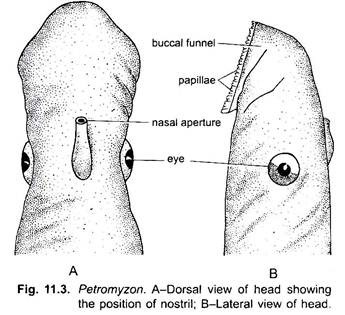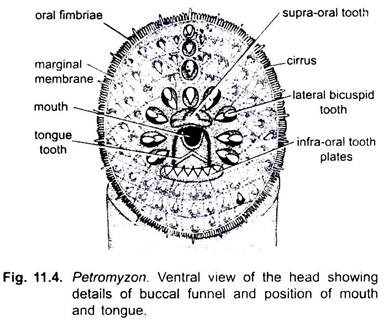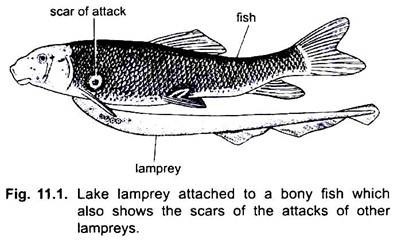In this article we will discuss about the external features of lamprey with the help of suitable diagrams. Also learn about its habit and habitat.
Shape and Size:
The body of adult Petromyzon is elongated, cylindrical and eel-like. Petromyzon marinus (sea-lamprey) attains a length of a metre, Lampetra fluviatilis (Lampern or common freshwater lamprey) reaches a length of about 90 cm, and Lampetra planeri (Sandpride or lesser freshwater lamprey) does not exceed 45 cm in length.
Colour:
The upper surface of the body is usually dark mottled greenish-brown. The surface of the body is smooth and slimy due to secretory epidermal glands. The scales are absent.
Division of Body:
ADVERTISEMENTS:
The body of Petromyzon is divisible in three regions, viz., head, trunk, and tail, which are not clearly demarcated. The head and trunk are nearly cylindrical and the tail is more or less laterally flattened.
Fins:
Paired fins are absent. There is a median dorsal fin which is divided into two unequal parts by a notch are placed near the posterior end. A caudal fin is present around the tail which is continuous with the posterior dorsal fin. The fins are supported by thin cartilaginous fin-rays. (In Lampetra planeri the female possesses an anal fin. This fin is reduced to a copulatory papilla in male).
Eyes:
ADVERTISEMENTS:
On either lateral side of head is present a well developed eye having no eyelids, but are covered by a transparent area of skin.
Apertures:
(i) Mouth lies at the apex of the buccal funnel bordered by a ring of cartilage.
ADVERTISEMENTS:
(ii) Nostril or nasohypophyseal aperture is single located mid-dorsally over the head in between the two eyes.
(iii) Just behind each eye are present a row of seven rounded external gill-slits.
(iv) At the junction of trunk and tail, on the ventral side is present a slit-like depression, the cloaca. Protruding through the cloaca is a urinogenital papilla bearing at its tip a minute urinogenital aperture. Anus lies just in front of papilla within the cloacal depression.
(v) Along each lateral side of the body and below the head are present numerous small sensory pores of the lateral line septum. In male Petromyzon is present an eversible penis.
Buccal Funnel:
The head region is characterised by the great forward development of a special cup-like structure called buccal funnel or sucker. It is actually a downwardly directed depression. The buccal funnel is surrounded by a marginal membrane which is provided with soft small projection called the oral fimbriae or papillae and the longer sensory cirri in between the papilla. The inside of the buccal funnel is beset with radiating rows of yellow, epidermal, horny teeth.
The teeth rest on cartilaginous pads and are principally mesodermal in origin. They are not homologous with true vertebrate teeth. The mouth IS a narrow, circular opening situated at the bottom of the buccal funnel. From below and behind the mouth projects a prominence, the so-called tongue bearing larger horny teeth. Immediately behind the median nostril a transparent area of skin indicates the position of the pineal organ.
Habits and Habitat:
Lampreys have almost world-wide distribution being present in both salt and freshwaters of North America, Europe, West Africa, Japan, Chile, Australia, New Zealand and Tasmania.
ADVERTISEMENTS:
Lampreys (Petromyzon) are both freshwater and marine forms. Its larval stage called ammocoete is a freshwater, sedentary, and filter feeding creature like Amphioxus. While some adult freshwater forms are free-living but the others are ectoparasitic on fishes and turtles. The lampreys are all carnivores, and although they are sometimes spoken as quasi-parasitic, they should properly be regarded as true predators, for they actually catch and eat their prey.
The method of feeding is peculiar and quite specialised. Lampreys are swift swimmers, capable of overtaking slower prey. The animal attacks fishes, turtles, etc., of many sorts, usually larger than itself It attaches itself by means of its circular mouth.
The mouth operates as a sucker or vacuum cup and has very tenacious holding power. While attached to the prey, it rasps or shreds the flesh of the prey with its tongue apparatus and horny teeth on the buccal funnel.
Lampreys usually live in sea and migrate to the rivers for the purpose of spawning. After spawning they usually die. In the river the lampreys do not eat anything, but live on the accumulated subcutaneous fat that provides the nourishment. They migrate to the river usually in autumn, while the sexual maturity attained in winter. But the breeding occurs in spring.
A freshwater lamprey, Petromyzon marinus unicolor migrates a few miles upstreams for the purpose of spawning. The brook lampreys (represented by the genus Lampetra) have the peculiar habit of nest-building at the bottom of the river where the eggs are laid. They select the bottom where both sand and stones are present. By the action of the suctorial mouth, they arrange the stones in such a fashion that a small depression is produced at the centre. Fertilisation is external.



